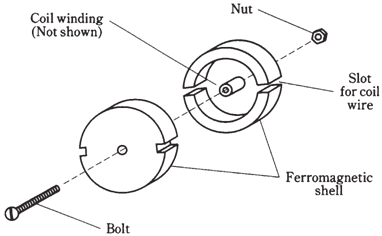Pot cores:
There is another way to confine magnetic flux in the coil so that unwanted mutual inductance does not take place. This is to extend a solenoidal core completely around outside the coil, making the core into a shell. This is termed as a pot core. Whereas in most of the inductors the coil is wound around the form, in the pot core the form is wrapped around the coil.

Figure-- A pot core shell. Coil winding is not shown.
The core comes in 2 halves, inside one of which the coil is wound. Then the parts are assembled with the help of bolt and nut. The whole assembly looks like a miniature oil tank. The wires come out of core through small holes.
Pot cores have same advantages as toroids. The core prevents the magnetic flux from extending outside the physical assembly. Inductance is increased as compared to solenoidal windings having a comparable number of turns. Actually, pot cores are even better than toroids if the main objective is to obtain an extremely large inductance within small volume of space.
The basic disadvantage of the pot core is the tuning, or adjustment of the inductance, is all but impossible. The only method to perform it is by switching in different numbers of turns, by using taps at various points on the coil.